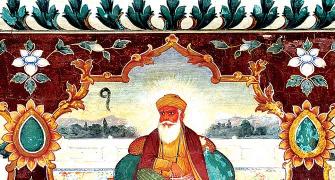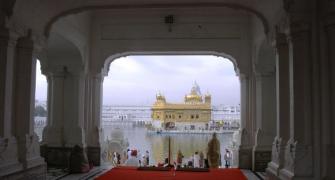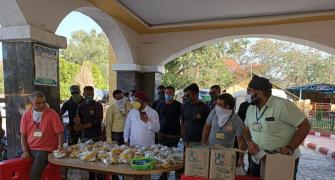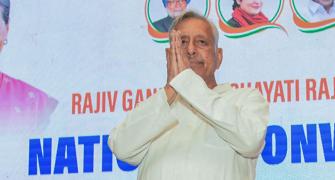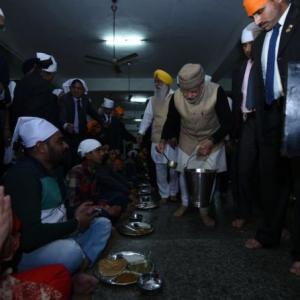It was truly heartening to see how the Sikh community had risen to the occasion during the Black Lives Matter peaceful protests and the coronavirus pandemic and selflessly served those looking for nourishment.
Payal Singh Mohanka reports from New York

Today, offerings at a langar in the US include pizzas, pasta, enchiladas, tacos, sandwiches, vegetable burgers as well as noodles. All photographs: Payal Singh Mohanka
Khavain kharchain ral mil bhai
Tote na aavai vadho jaiyee.'
(The siblings of destiny eat and spend together.
But these resources do not diminish, they continue to increase).
The soulful strains of this shabad, a hymn from the Guru Granth Sahib, the holy book of the Sikhs, urging the community to unhesitatingly share and feed others echoes in my ears as I watch devotees pouring into a large hall and sitting in neat rows to enjoy the langar or offerings of the community kitchen at the Baba Makhan Shah Lubana Gurdwara in Queens, one of New York City's five boroughs.
Langar in Sikhism refers to the free meal served in gurdwaras to all irrespective of colour, creed, economic status or ethnicity.
This was a revolutionary concept in the 16th century when society was fractured with discrimination based on religion and social standing.
This community kitchen was an attempt to uphold the principles of equality among people.
"Anyone can come in at any time. If you need food, you can knock on the door in the middle of the night, someone will serve you at any gurdwara around the world. Our gurdwara serves langar to 600 people every day," elaborates Gurmej Singh, past president of the gurdwara which was set up two decades ago.

Born in 1469, Guru Nanak Devji was the first Guru of the Sikhs and the founder of the faith.
He had as a young man received Rs 20, a significant sum in those days, from his father to start some work.
"But rather than start a business he felt that there was no work greater than feeding the hungry. This tradition has passed down the ages," adds Baldev Singh Gilzian, president of the gurdwara.

The Golden Temple in Amritsar has set a world record for the largest free kitchen.
Fifty thousand people savour the langar each day, while religious occasions and holidays see twice the number.
For an Amritsar-born Sikh, living in Kolkata, the concept of langar isn't new and neither is the community's spirit of service alien to me.
The Sikh Gurus believed that as long as you shared, there would always be abundance.
But what certainly stirred my interest is the way the idea of langar has slowly evolved in the West.
Here in New York I visited a couple of gurdwaras and it was truly heartening to see how the Sikh community had risen to the occasion during the Black Lives Matter peaceful protests and the coronavirus pandemic and selflessly served those looking for nourishment.

In the frontline to provide and nurture, gurdwaras are on the alert in times of crisis.
During 9/11, 100,000 bottles of water were distributed on Fifth Avenue in Manhattan.
Natural calamities like Hurricane Sandy that wreaked havoc in 2012 also witnessed gurdwaras pitching in with all their might.
The current pandemic has seen upto 5,000 people being fed in a day.
The Baba Makhan Shah Lubana Gurdwara also sent large quantities of provisions like wheat, pulses and ghee to the Golden Temple in Amritsar as well as the Bangla Sahib Gurdwara in New Delhi, which distributed food for 400,000 people a day when the pandemic was at its peak.

A steady supply of essentials from donors helps the gurdwara committee and its kitchens to ensure round the clock langar services.
Sometimes the response is overwhelming.
While Indians are aware of the concept of langar in a gurdwara, appreciative non-Indians, truly humbled by the experience, cannot fathom why unlimited food is distributed without any payment.
Numerous thank you letters flood the gurdwaras.
"Their sheer gratitude at receiving a satisfying hearty meal is truly touching," say members of the gurdwara's managing committee and it is this that motivates the chefs and the sincere band of innumerable volunteers in the kitchen who keep the wheels of service moving.

While the US has many gurdwaras, New York with 100,000 Sikhs has around 20 registered ones, of which 10 are very popular.
Today conscious of dietary preferences, gurdwaras are mindful of organic produce, less fat and no sharp spices.
It was interesting to learn they have even gone one step further.
Keeping in mind the palate of the communities that are being served, gurdwaras are now flexible and when required move away from the earlier langar menu comprising dal, vegetables, chapatti, rice, yogurt, salad and kheer
Abiding by the tenets of Sikhism and preparing strictly vegetarian food in the kitchens of the gurdwaras, the standard repertoire has undergone a cultural shift.
Today, offerings at a langar in the US include pizzas, pasta, enchiladas, tacos, sandwiches, vegetable burgers as well as noodles.
While younger Indians are delighted with the change this offers from their usual Indian home cuisine, non-Indians too are suitably satiated with the familiar fare being served.

Not too far on 118th street in Queens is the oldest and largest gurdwara in the East Coast of the US, the half-a-century-old, Sikh Cultural Society Gurdwara.
In collaboration with organisations like the Sikh Centre of New York and the Sikh Coalition, this gurdwara at the height of the pandemic received requests from New York State to serve food packets in hospitals, at centres established for COVID-19 testing as well as quarantine centres.
They geared up to the task.
Each week, they prepared takeaway packets for 10,000 people which would be collected from the gurdwara premises, while over 30,000 meals were distributed at hospitals and centres.

Sheer practical factors prompted authorities to embrace a few changes.
Since the food had to be packed, they had to opt for drier alternatives than the typical langar fare.
Rice and pita bread were found to be better options than chapattis.
As the crisis struck in summer, food could not be left outside for too long.
Trucks with storage facilities were organised to transport thousands of food packets.
Donations poured in to keep their efforts going.
During the pandemic, like everyone else gurdwaras too faced an unprecedented situation.
After a brief closure, they got their act together.
Special stalls were set up outside the premises to collect food packets.
Those who were unable to reach, would telephone the gurudwara which would then deliver it to them.
"There were huge challenges. But there is no service without challenge," says Sukhjinder Singh Nijjar of the Sikh Cultural Society.
They even distributed 500,000 face masks as hospitals and the police force were running short.
Keeping the fear of another surge in mind, gurdwaras have now opened up with appropriate protocol in place: Temperature check, masks, social distancing maintained and routine sanitisation undertaken.
The main prayer hall restricts the congregation to a quarter of their usual occupancy.
As a token of appreciation for the continued contribution of the vibrant Punjabi population, last month the city council renamed 101st Avenue in Queens, 'Punjab Avenue', much to the delight of the community.
Like Little Italy in Manhattan, there is Little Punjab here in Queens: Sikh Punjabis, Hindu Punjabis and Muslim Punjabis have made Queens their home.
Enthused with new vigour and a sense of belonging, the well-assimilated Punjabi community in Queens owns businesses, helps raise funds for worthy causes and is also involved in local politics besides churning out wholesome meals.
"This ancient custom of langar started by Guru Nanak Devji will never end," says Sikh Cultural Centre President Jatinder Singh Boparai. "If you go to any gurdwara anywhere in the world you will get a hot meal. No one will sleep hungry, no one will die hungry. This is part of Sikhism. This is the teaching we get from our ancestors and the Shri Guru Granth Sahib."
Upholding a five-century-old tradition, even today in the midst of adversity and a polarised world, gurdwaras strengthen their resolve and continue providing sustenance without discrimination.
For me it was a matter of pride to see Guru Nanak Devji's message of sewa or service before self being practised in a foreign land.
A constant reminder of the oneness of humanity.
Feature Presentation: Ashish Narsale/Rediff.com


